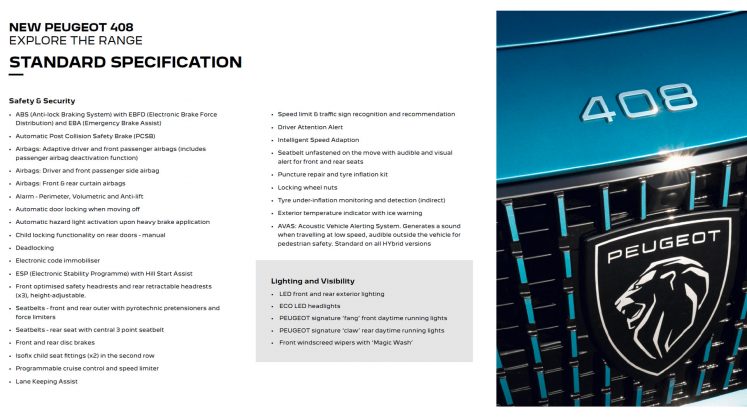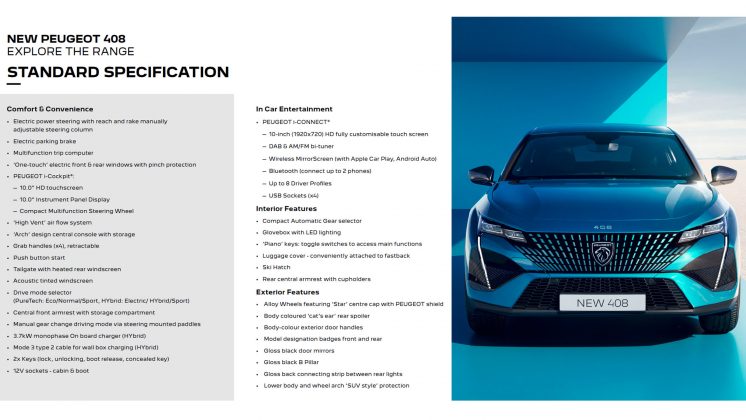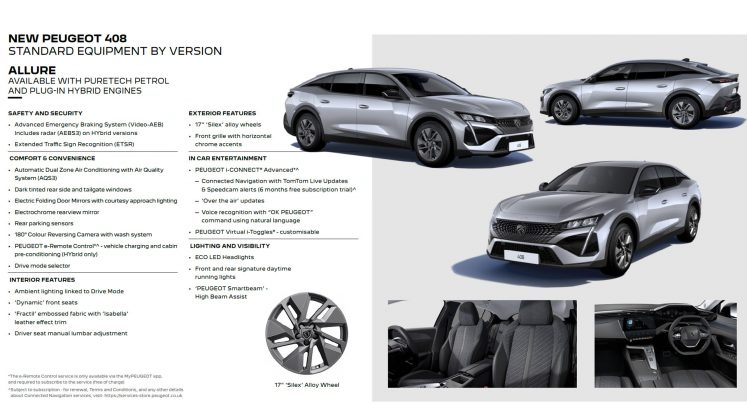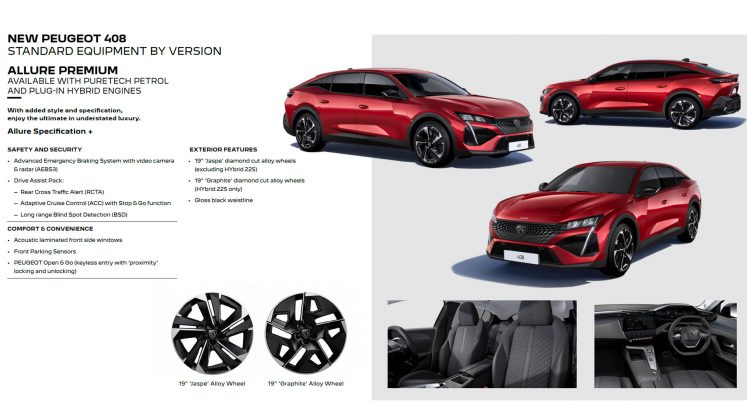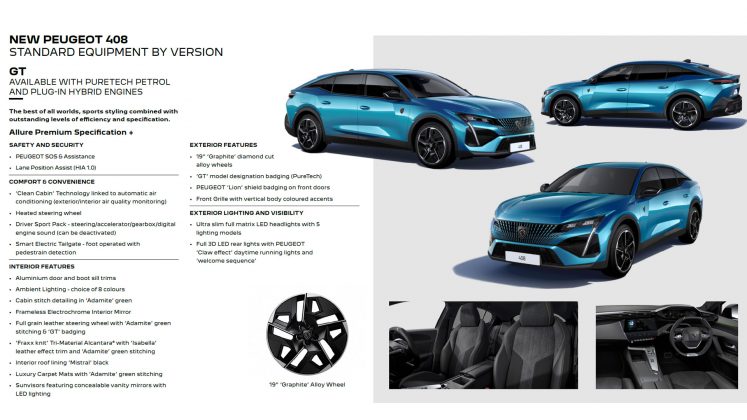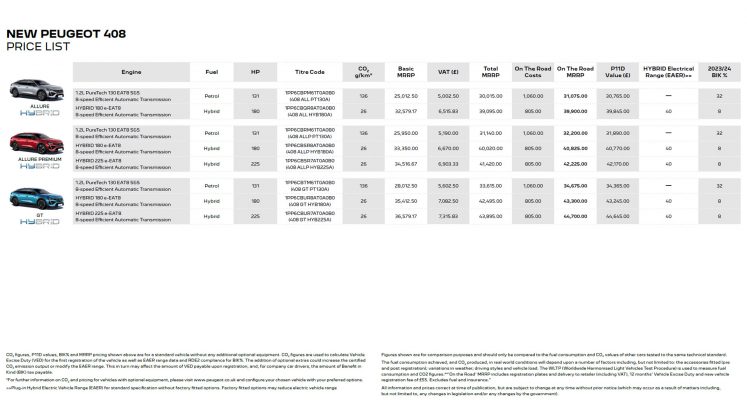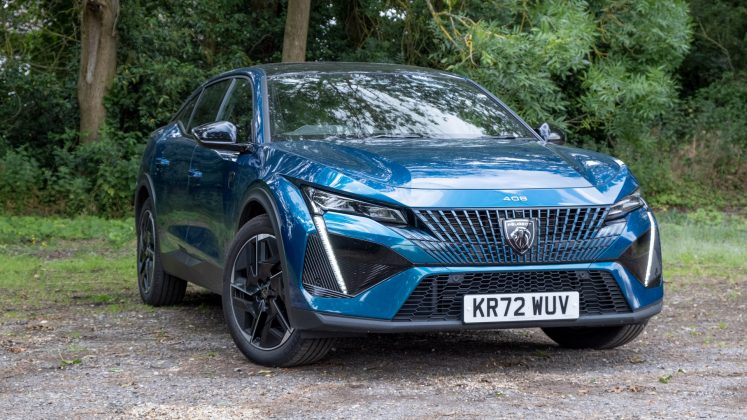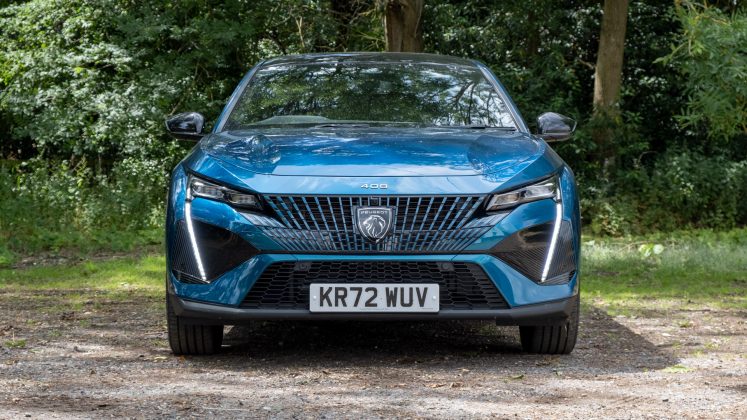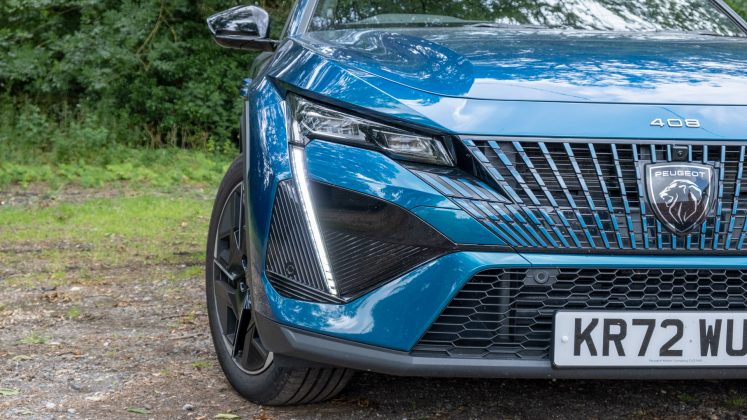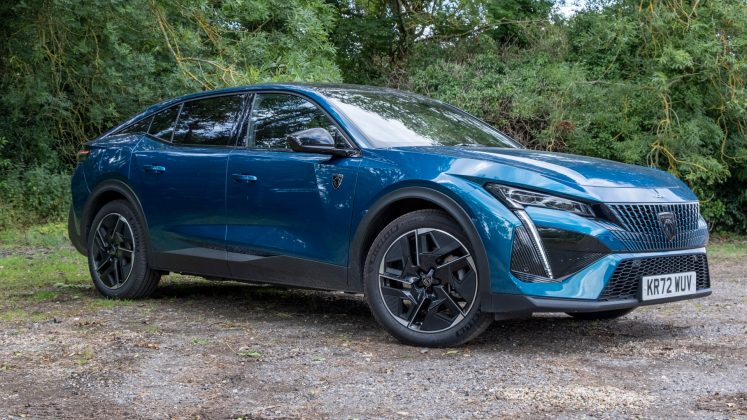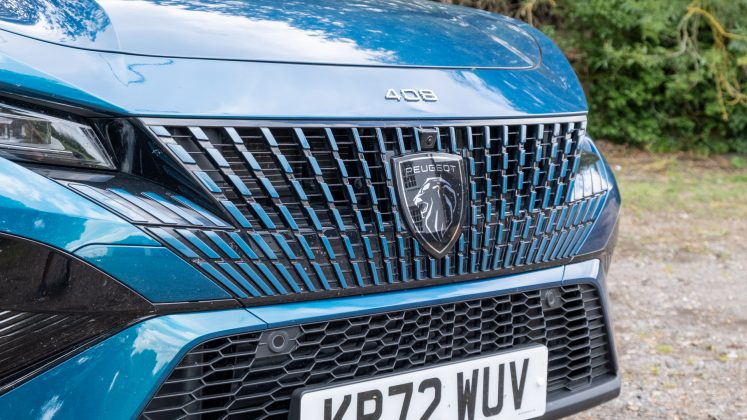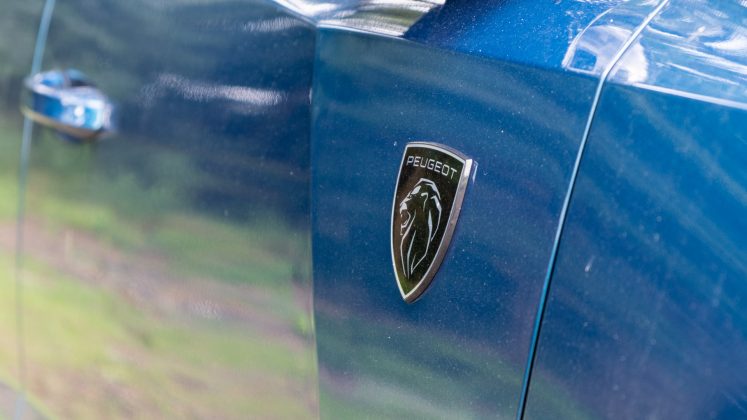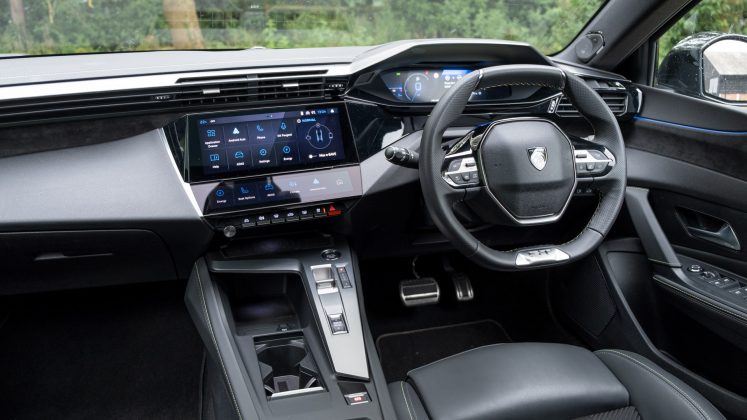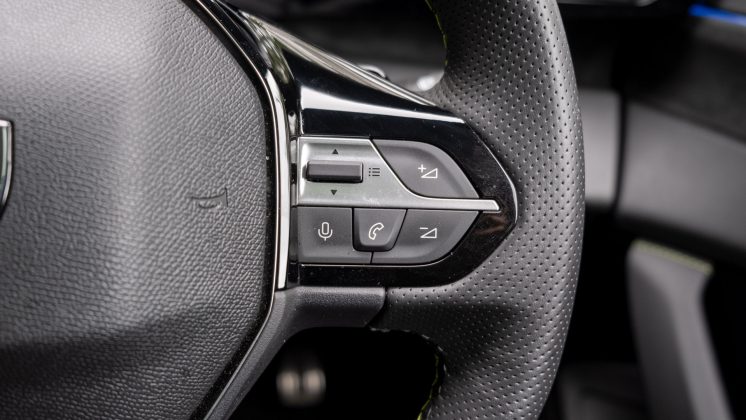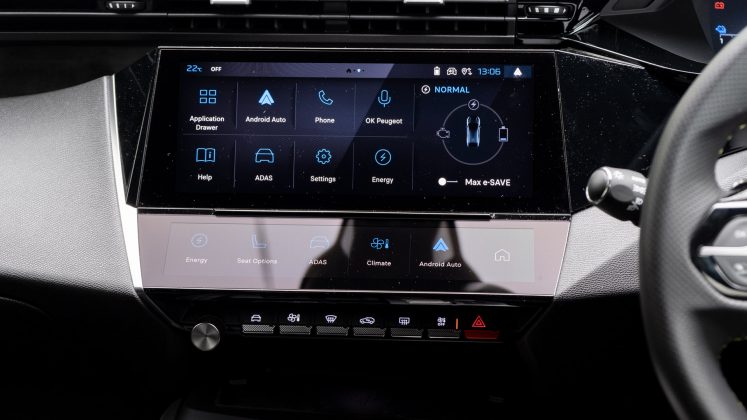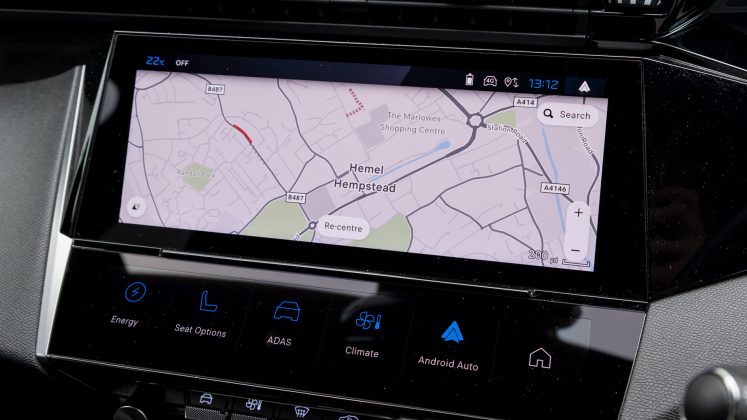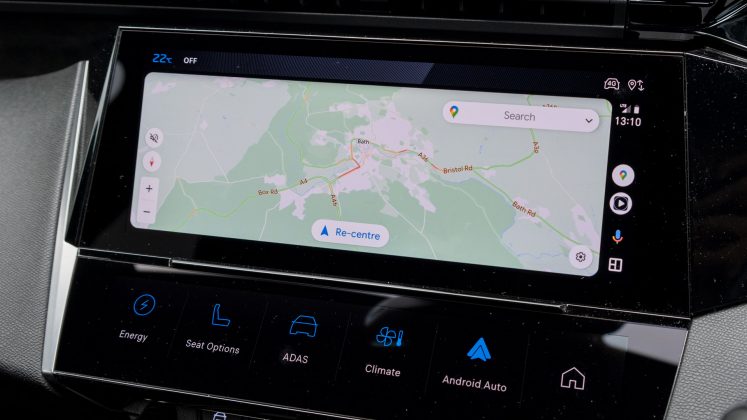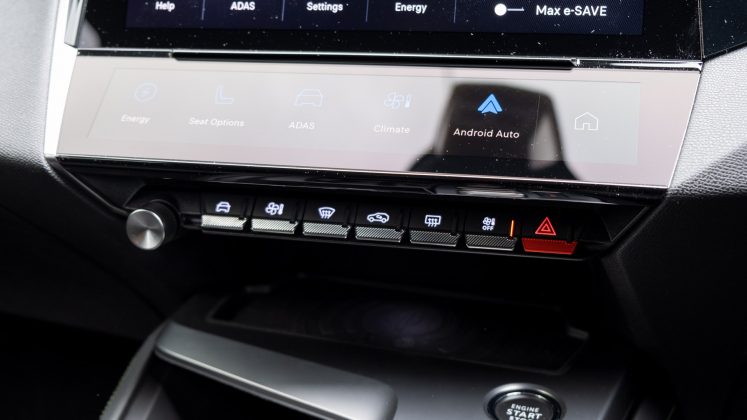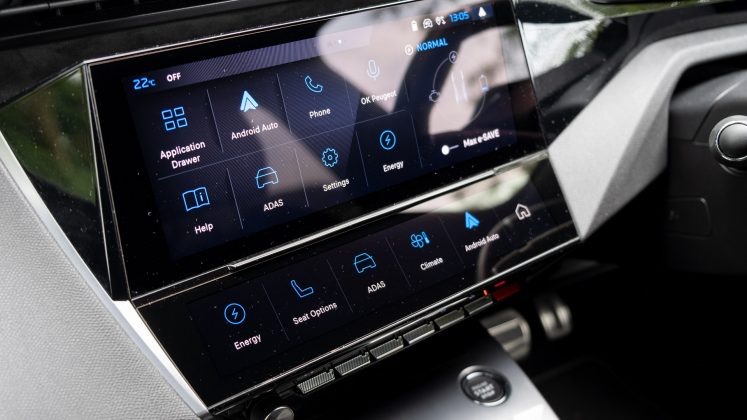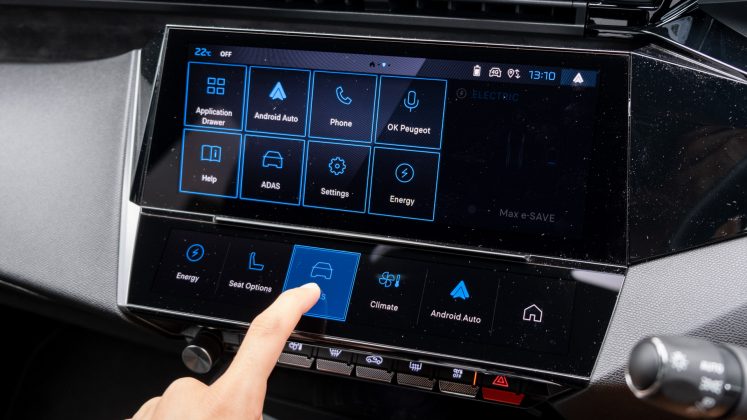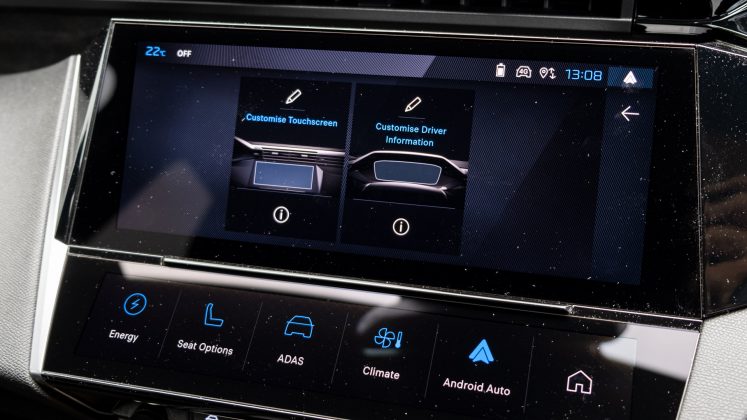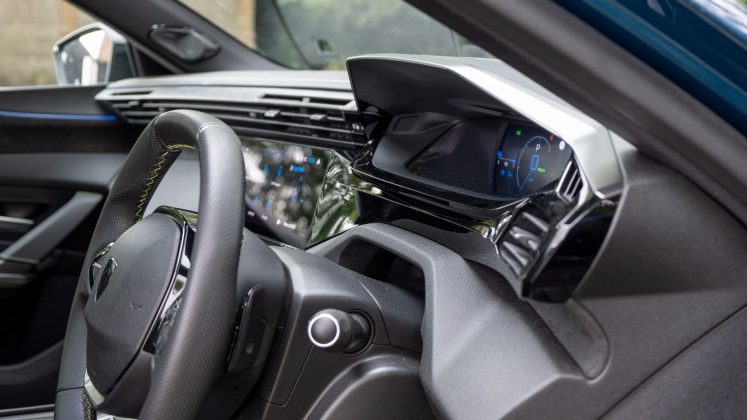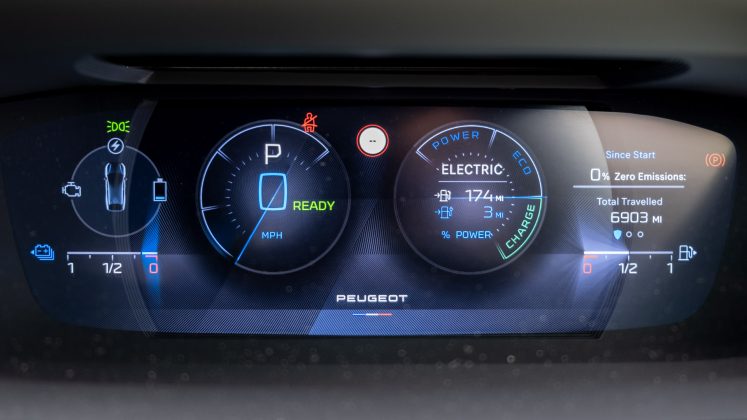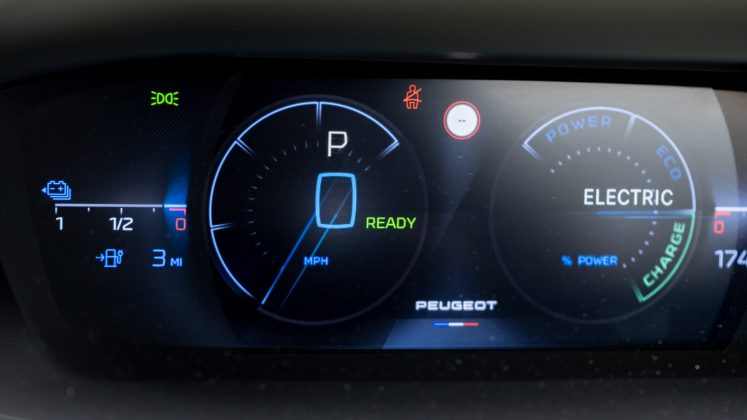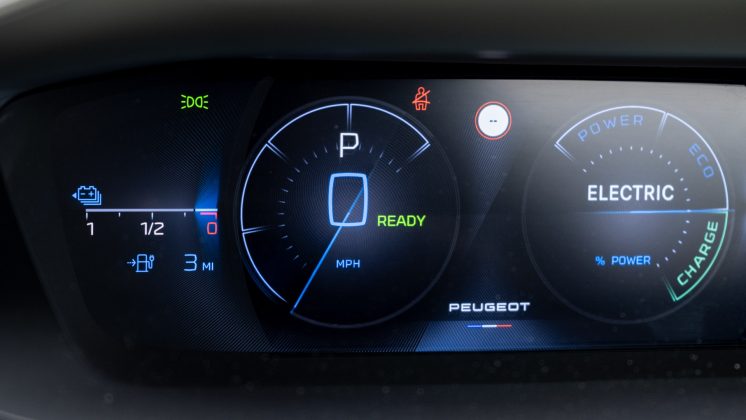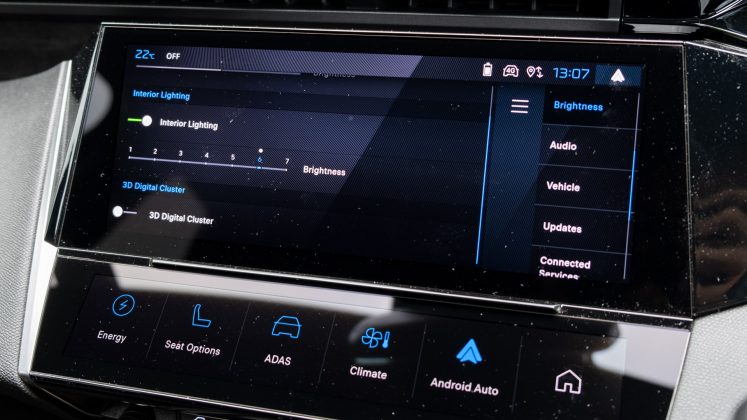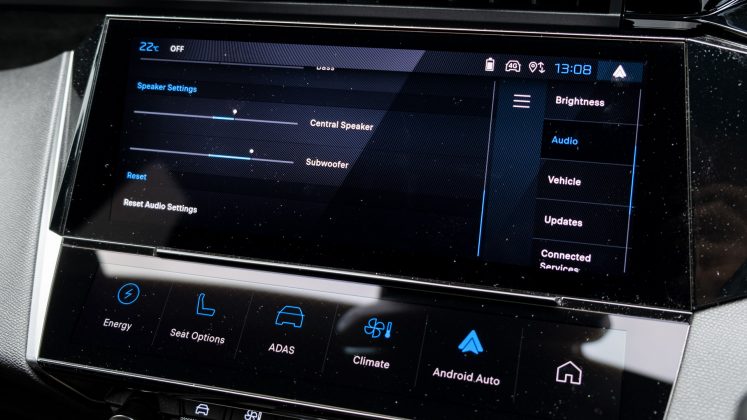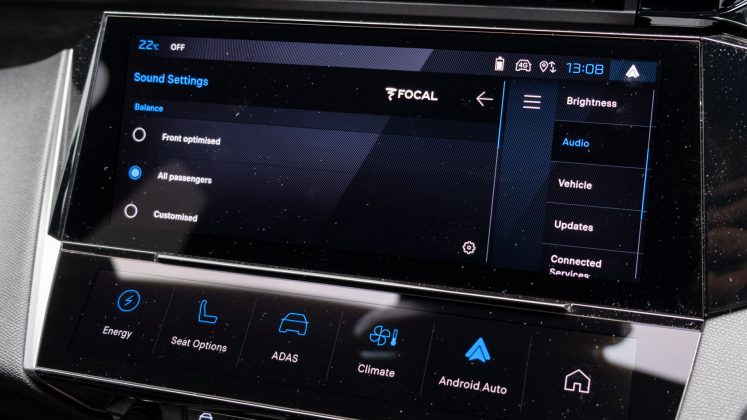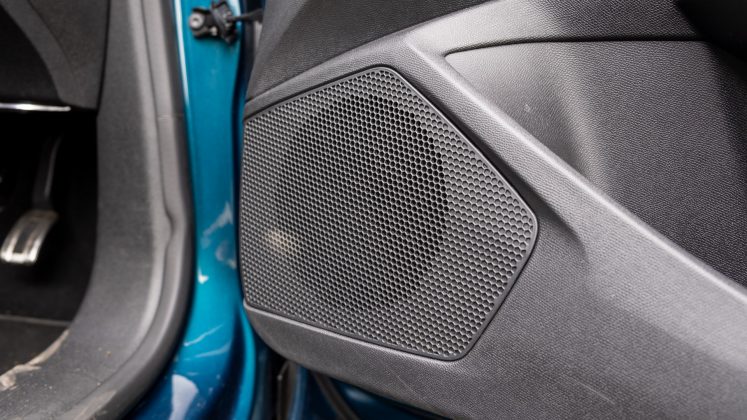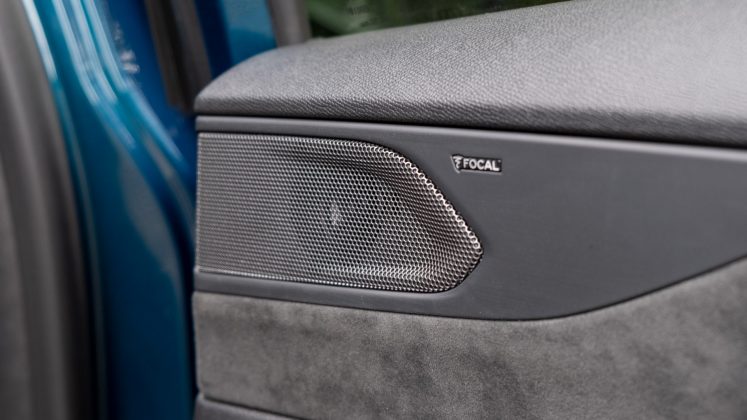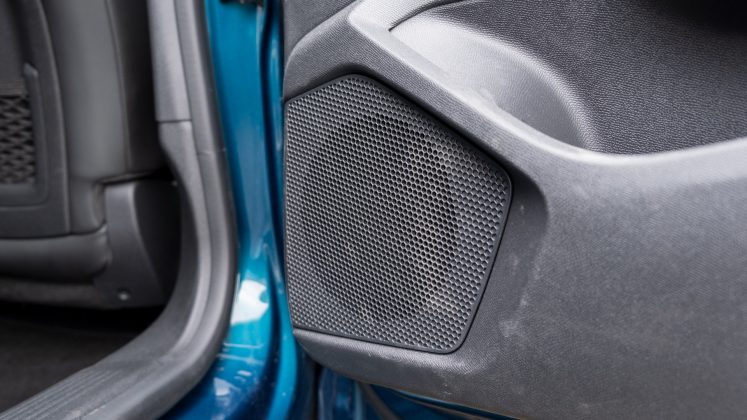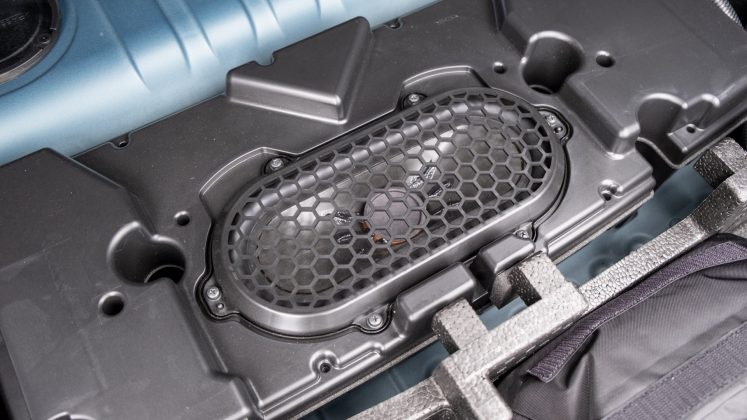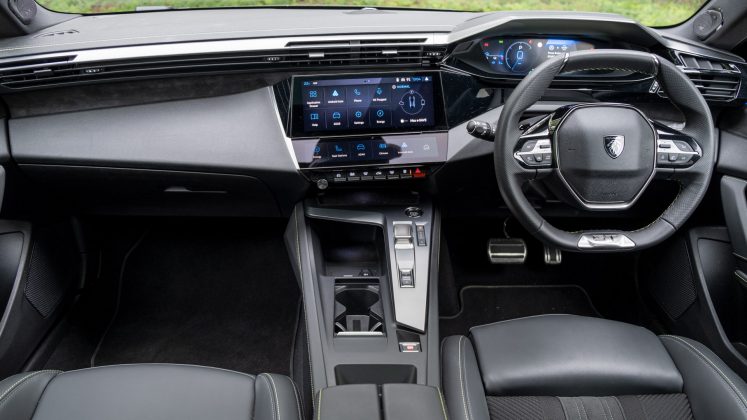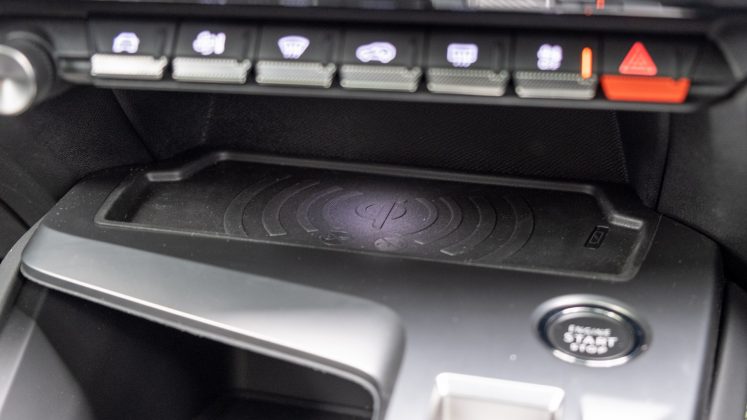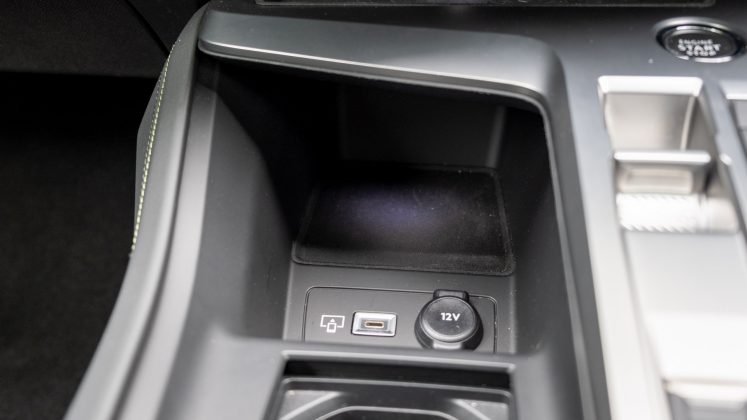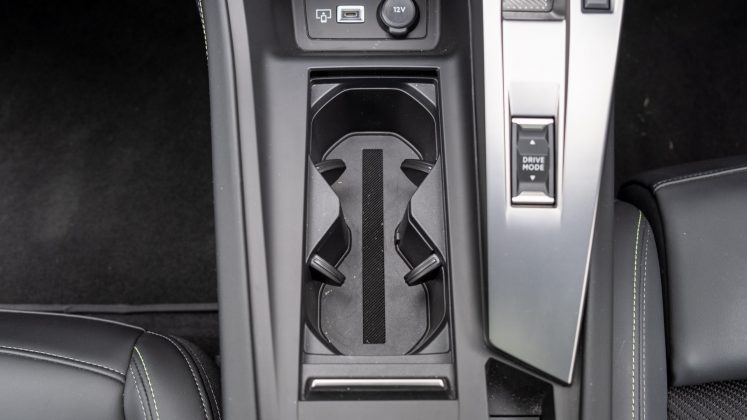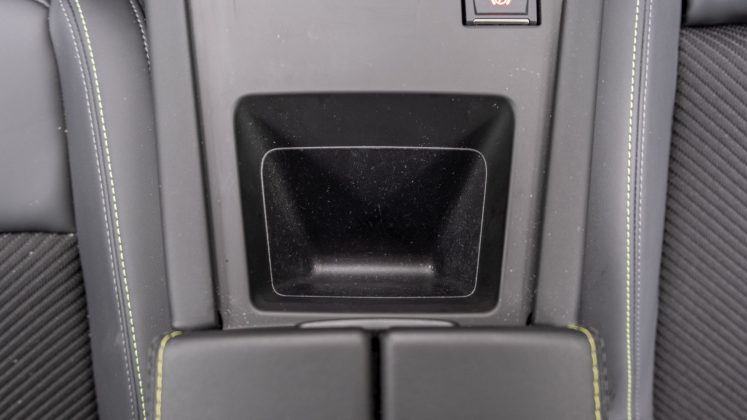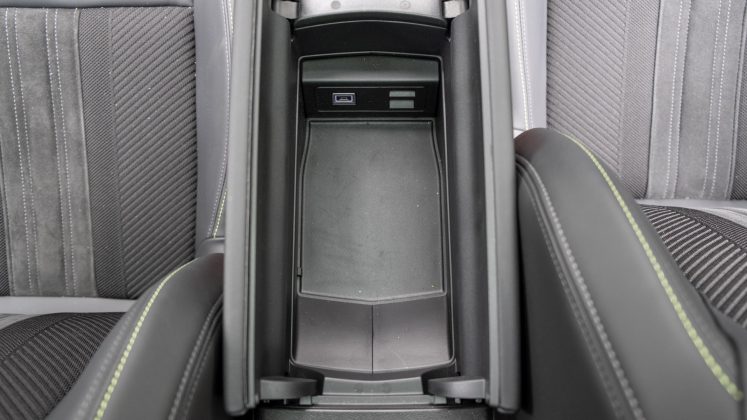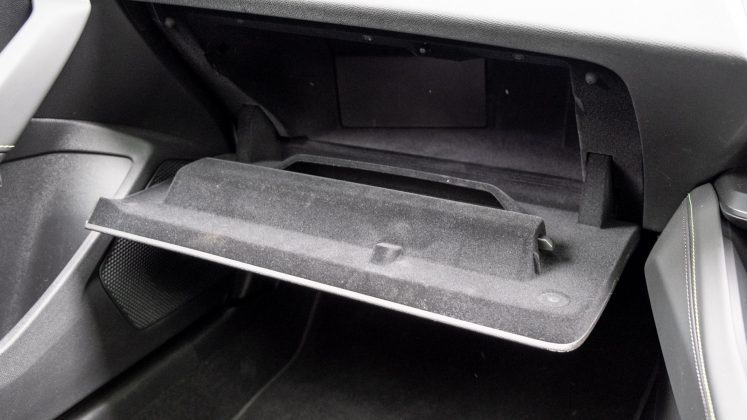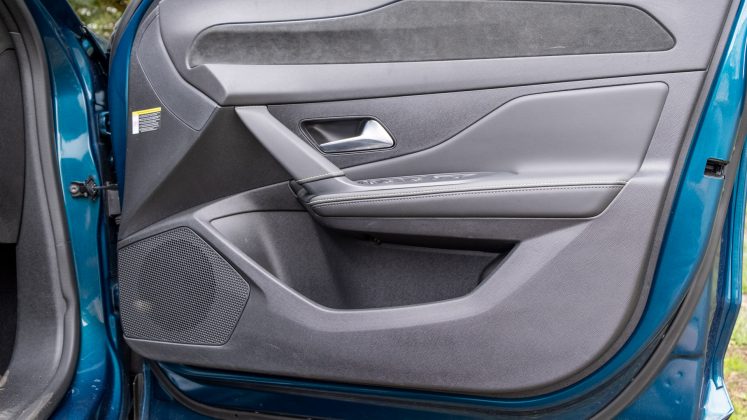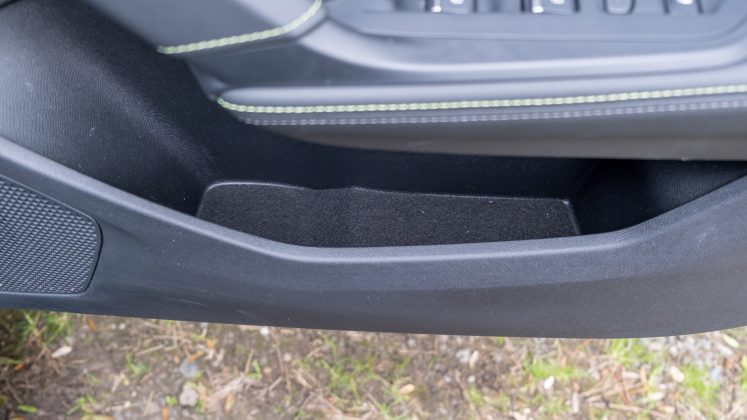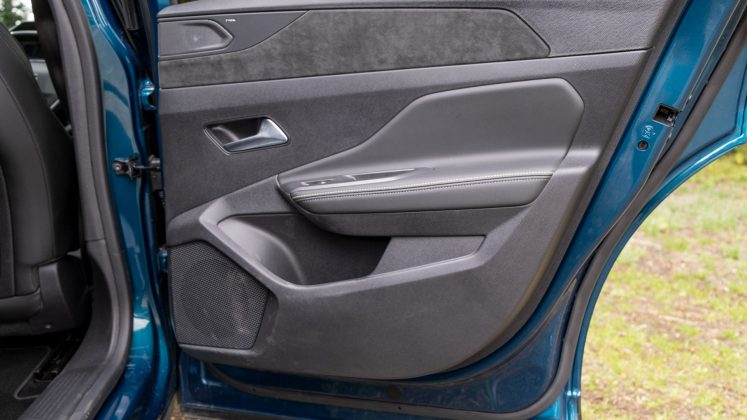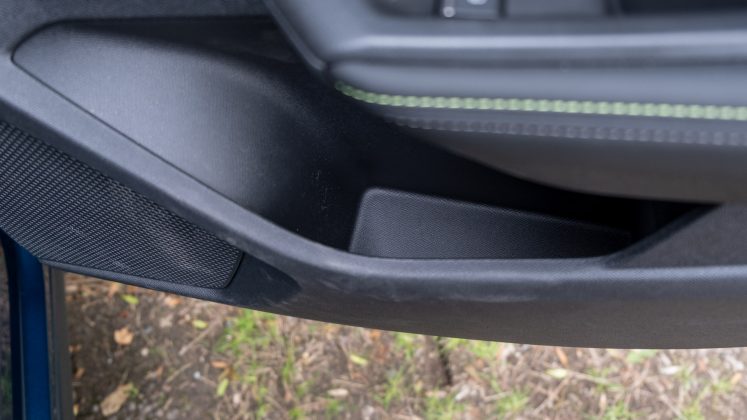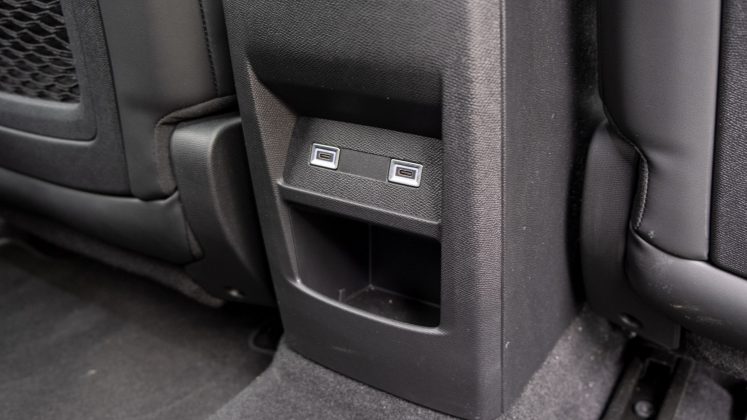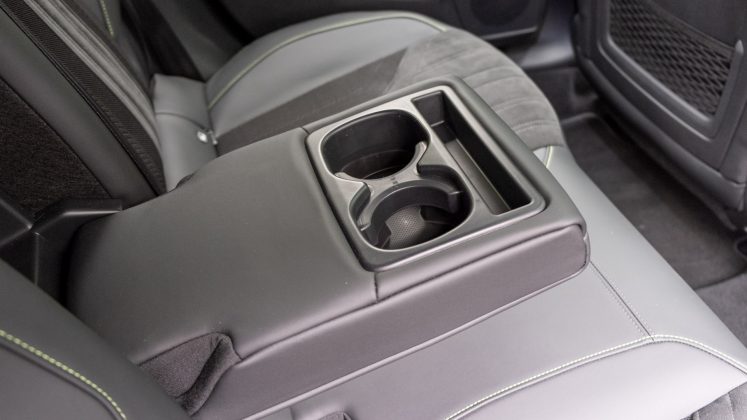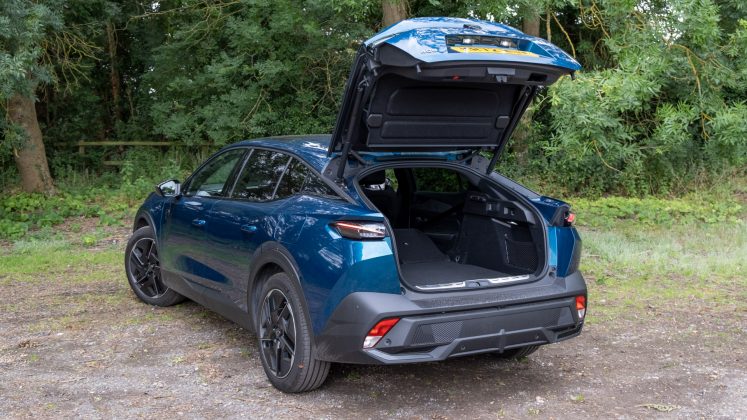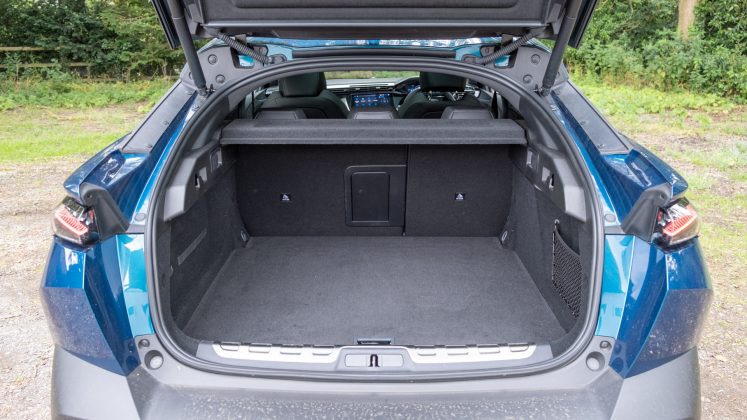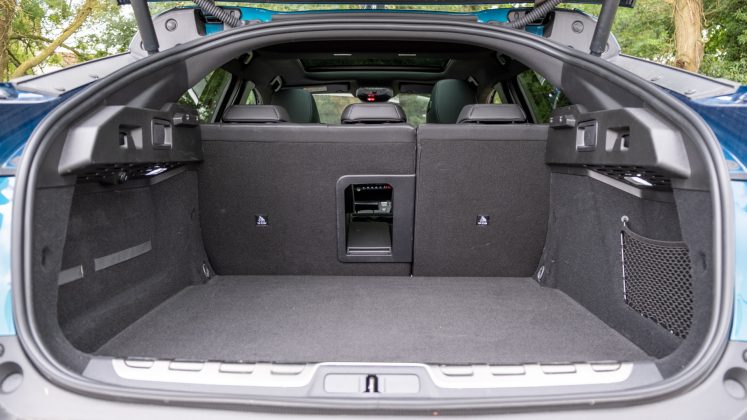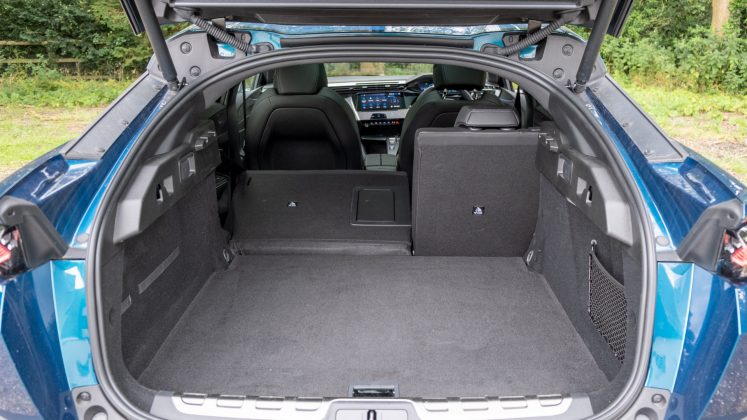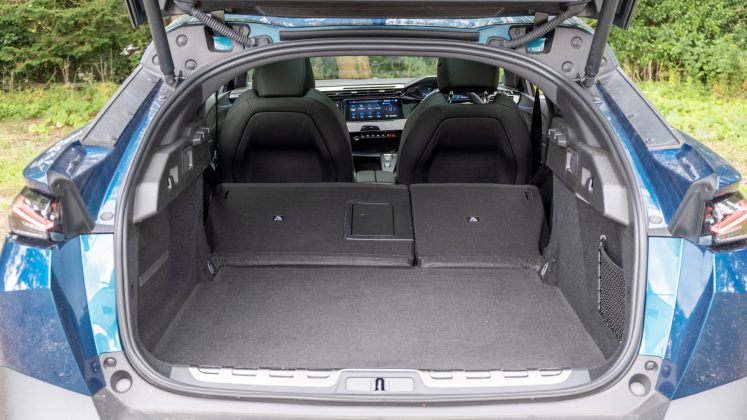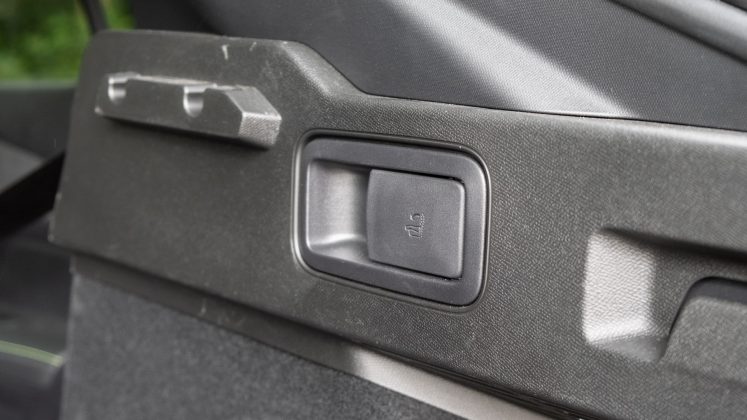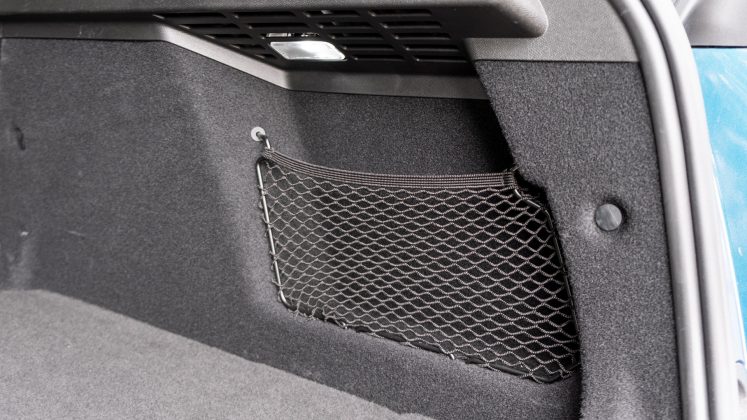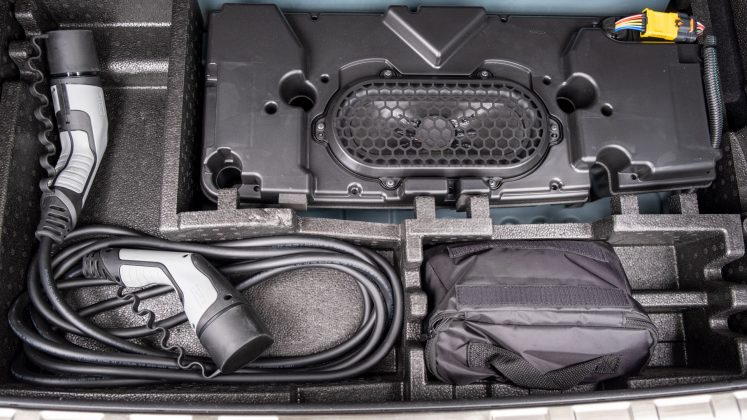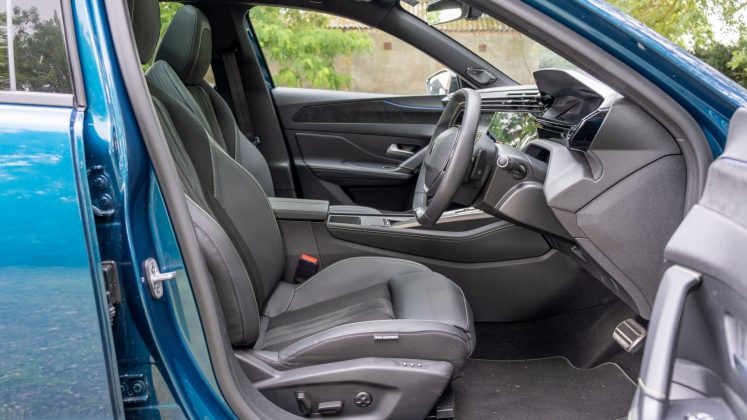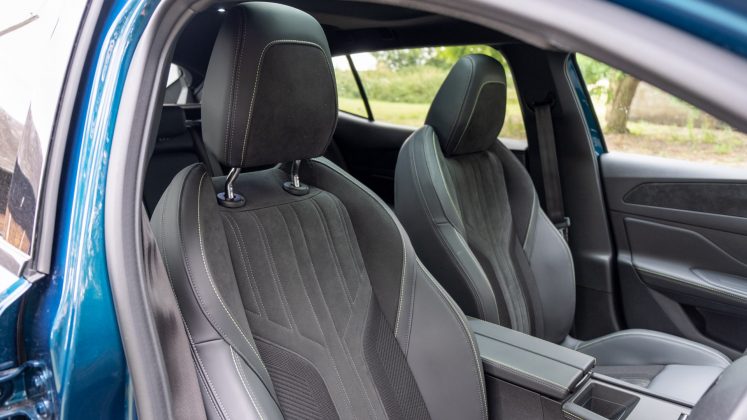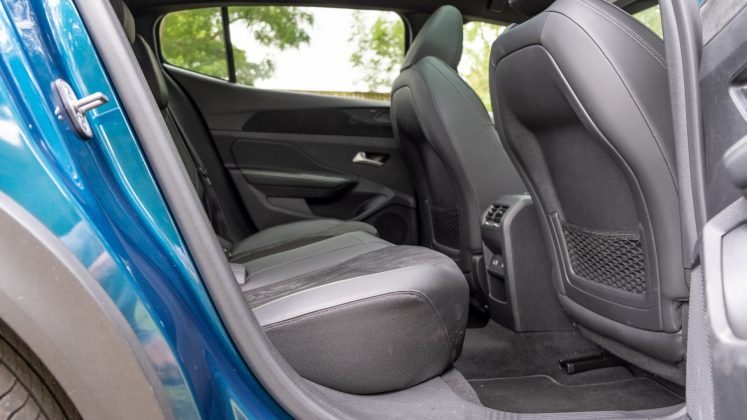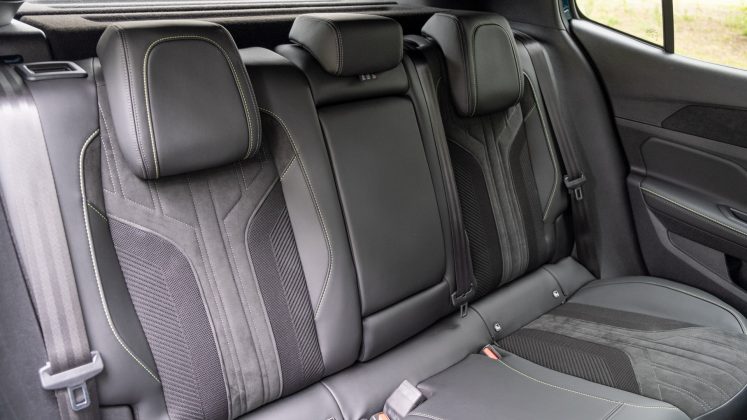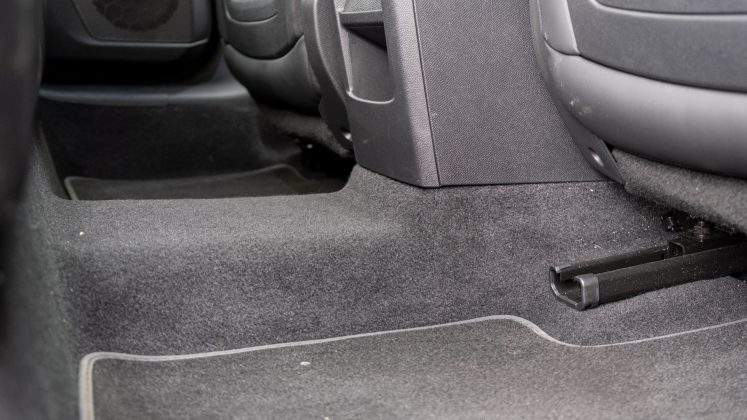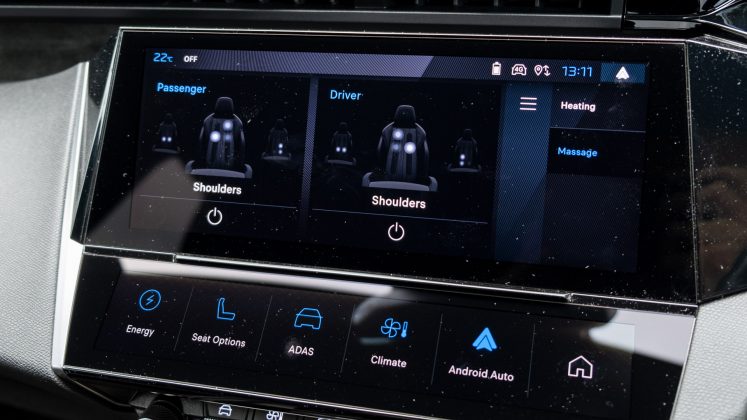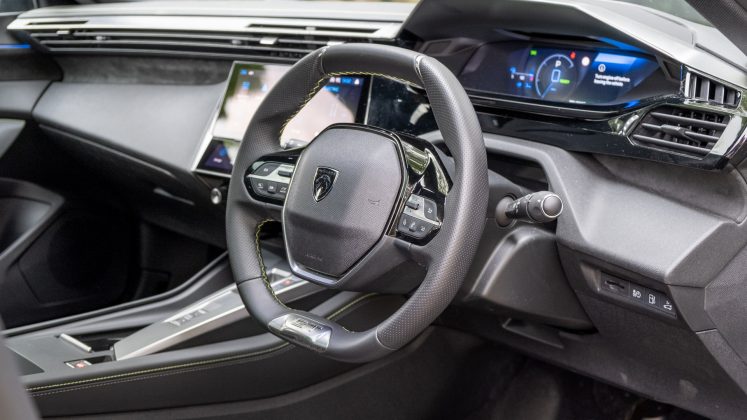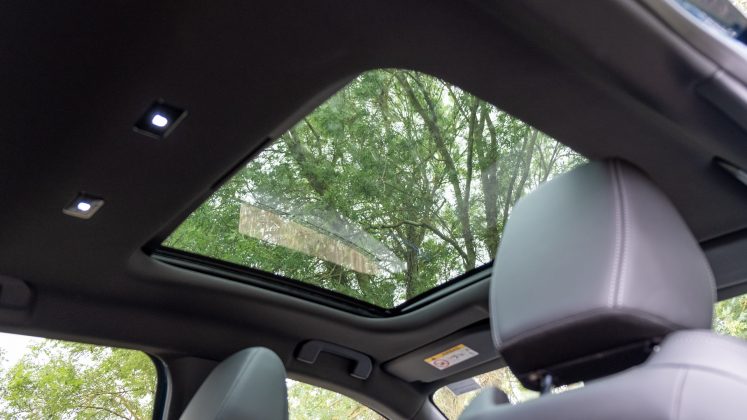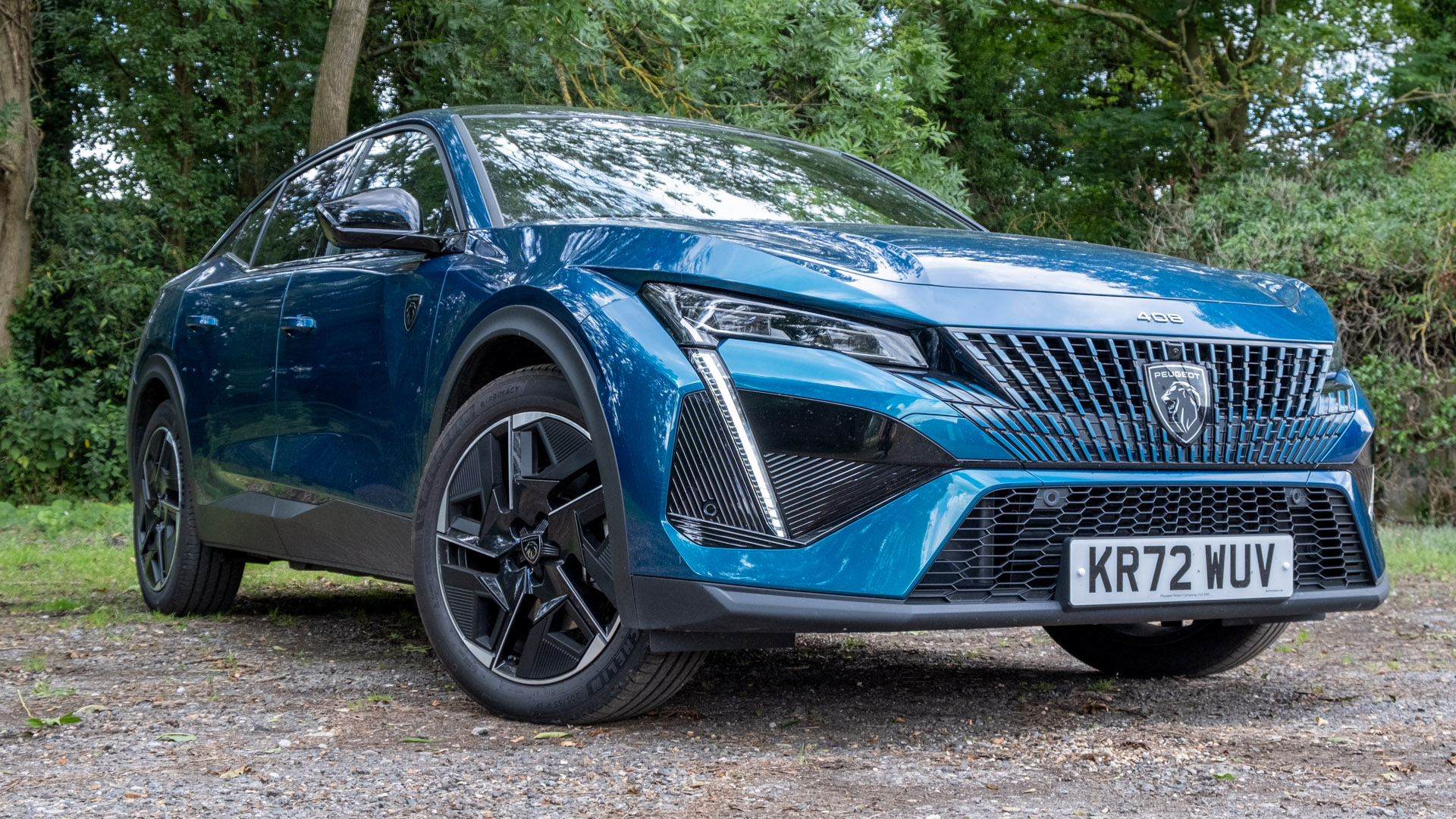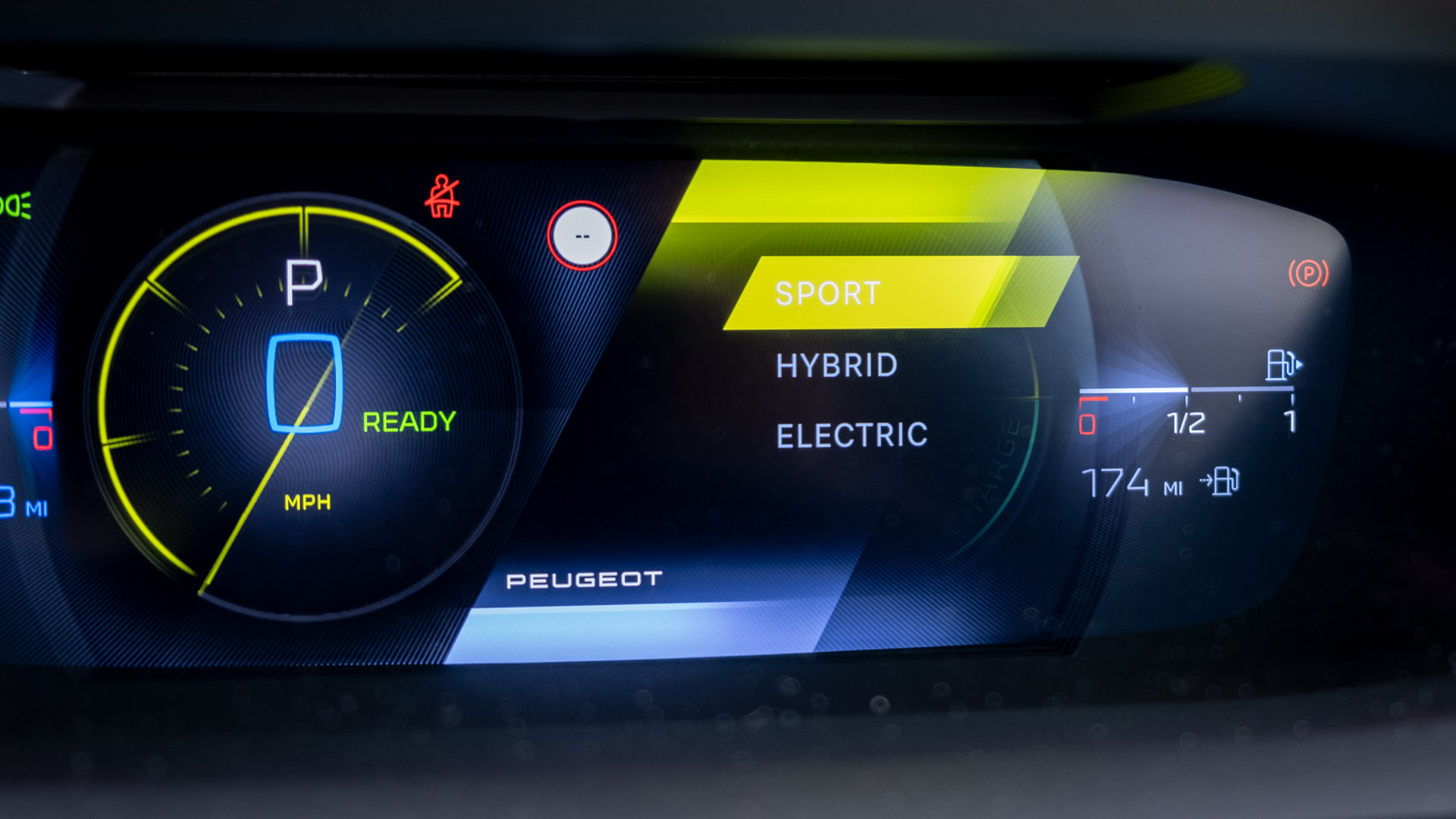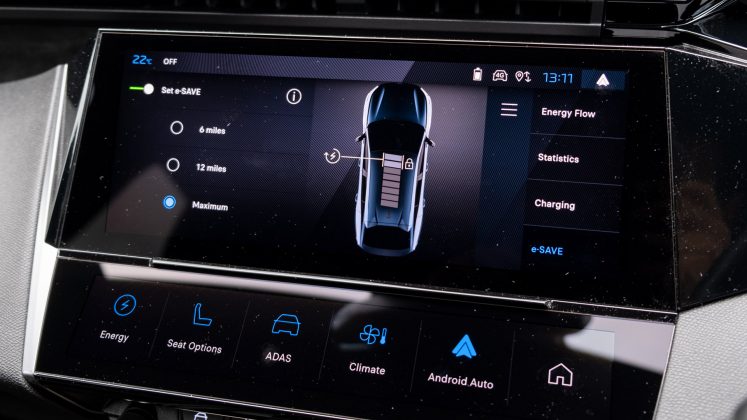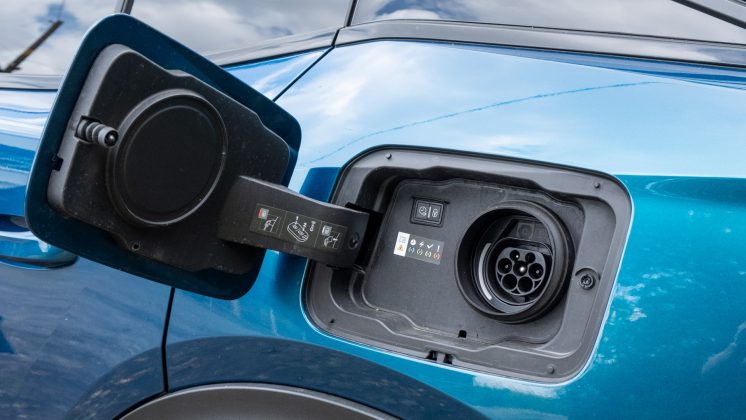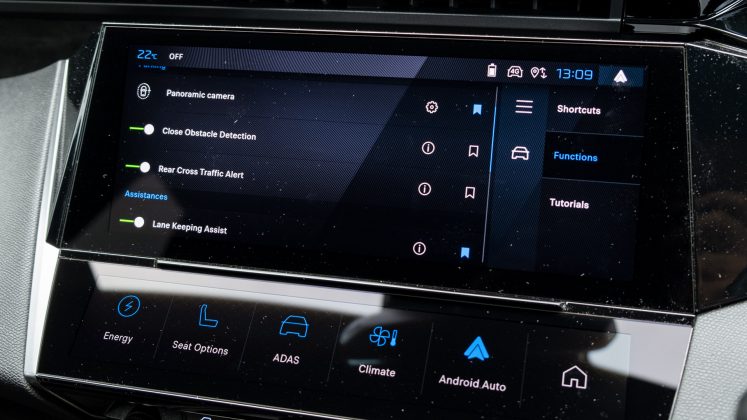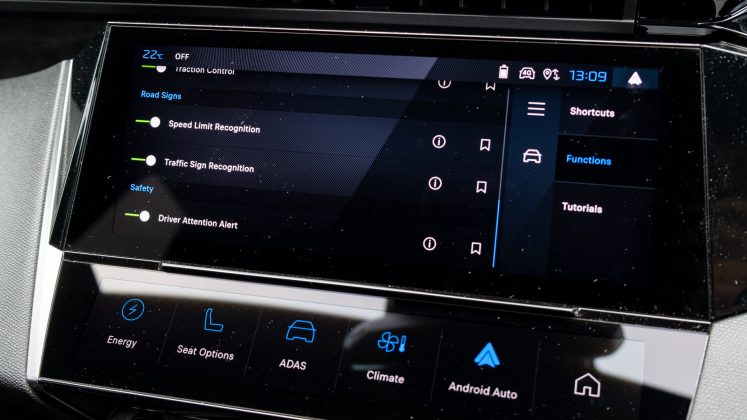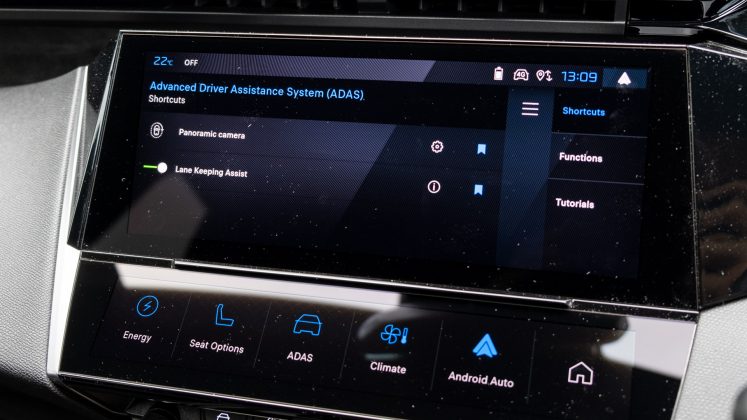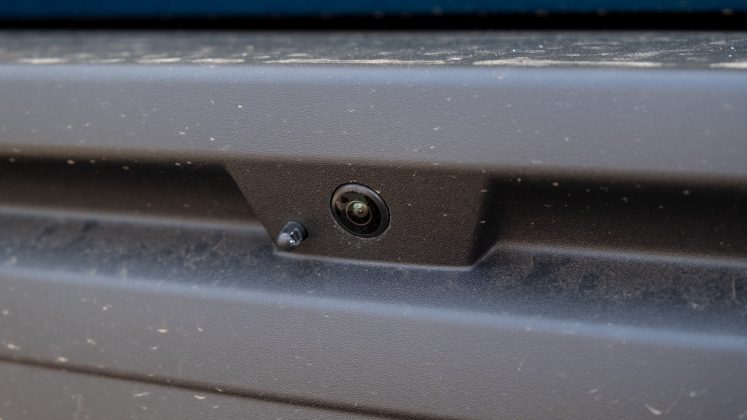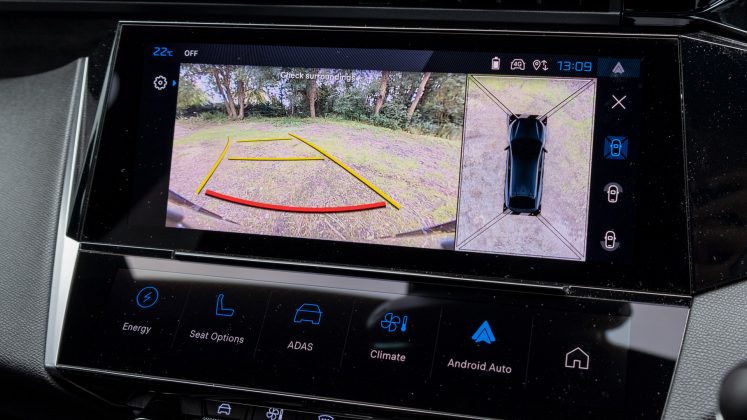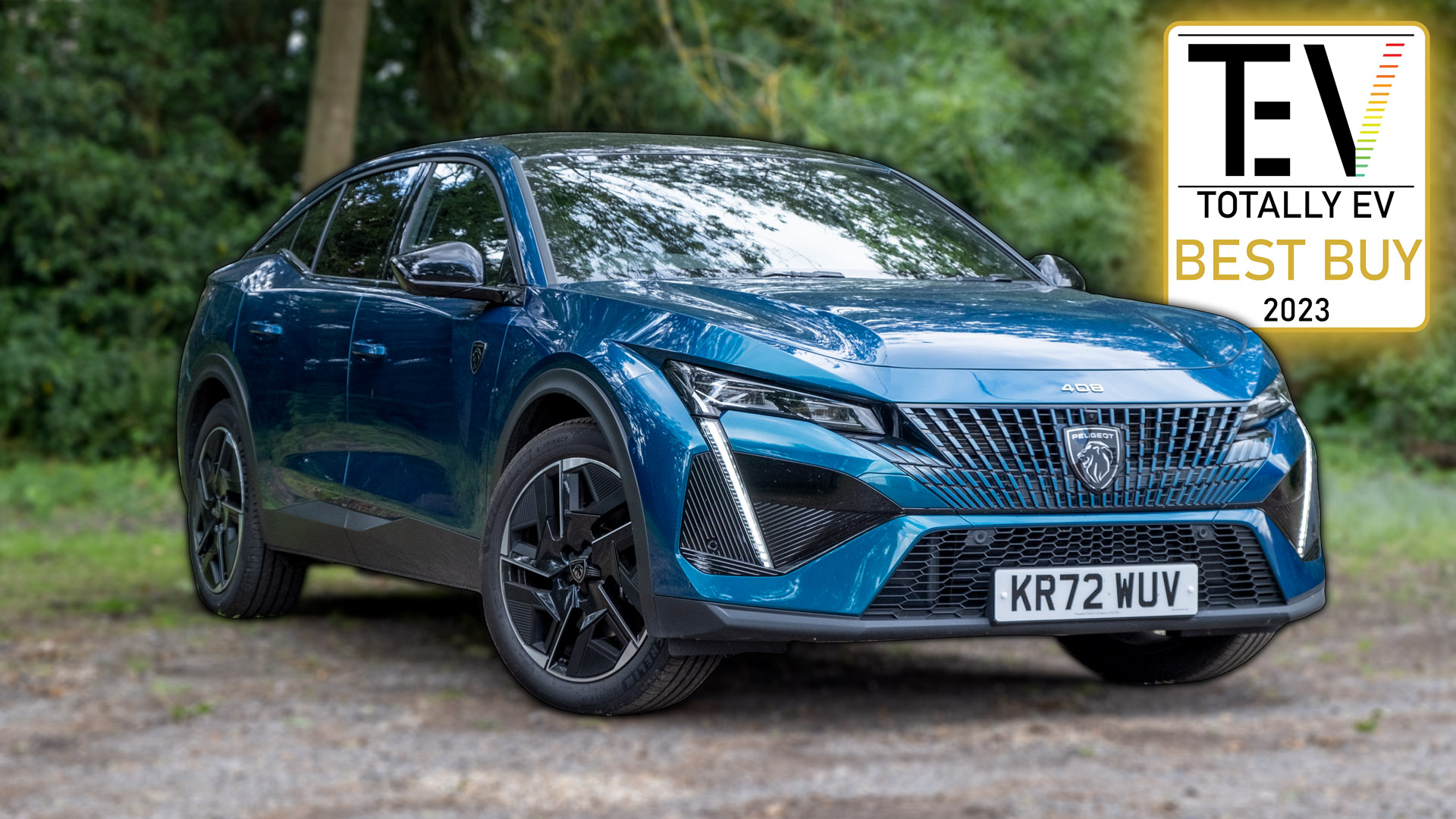The Peugeot 408 is a cross between an estate, a saloon and an SUV. Much like its near-identical sibling, the Citroen C5 X, the vehicle has a rather unique design. It’s available with a few different powertrains, with the plug-in hybrid model that we have on review being the most powerful out of the bunch. Unsurprisingly, this also means the PHEV is the priciest in the manufacturer’s line-up.
If you’d prefer to watch a review of the Peugeot 408 Hybrid, head on over to our YouTube channel.
Peugeot 408 Hybrid price & competition
At the time of writing, the Peugeot 408 Hybrid is available in three trims: Allure (£39,900), Allure Premium (£40,825) and GT (£43,300). These all come with a 1.6-litre petrol engine that combines with the 12.4 kWh battery pack and an electric motor to produce 133 kW (180 hp) and 360 Nm of torque.
Should you want a bit more power from its front-mounted engine, you’ll want to look at the 225 models, which produce 165 kW (225 hp) and 360 Nm of torque. These are available in the Allure Premium and GT trims for £42,225 and £44,700, respectively.
Find the best Peugeot 408 deals
In comparison, the regular petrol model, which houses a 1.2-litre engine, produces 96 kW (131 hp) and 230 Nm of torque. It’s no surprise then that it’s quite a bit cheaper: Allure (£31,075), Allure Premium (£32,200) and GT (£34,675). A full breakdown of the trims and powertrains can be found below (click to expand):
In terms of the alternatives, there are numerous hybrids to consider: the Nissan Juke Hybrid from £27,250; Honda HR-V from £30,695; MG HS PHEV from £31,095; Nissan Qashqai e-Power from £34,020; Peugeot 3008 Hybrid from £34,180; Citroen C5 Aircross from £36,875; Nissan X-Trail e-Power from £36,965; Citroen C5 X Hybrid from £38,220; Cupra Formentor e-Hybrid from £39,895; Kia Sportage PHEV from £40,545; Ford Kuga PHEV from £40,555; Hyundai Tucson PHEV from £41,930; Range Rover Evoque P300e PHEV £49,000; Suzuki Across Hybrid from £49,529; Audi Q5 TFSIe from £55,105; and the BMW X3 xDrive30e from £56,515.
Buy a car phone mount on Amazon (Affiliate)
You might also want to consider a few of the fully electric alternatives: the MG ZS EV from £30,495; Hyundai Kona Electric from £34,995; Kia Soul EV from £32,875; Citroen e-C4 from £30,569; Citroen e-C4 X from £31,610; Peugeot e-2008 from £36,500; Kia Niro EV ‘2 64’ from £37,325; Vauxhall Mokka-e from £37,610; Volkswagen ID.4 from £42,640; Skoda Enyaq iV from £40,585; Hyundai Ioniq 5 from £43,445; BMW iX1 from £44,560; Tesla Model Y from £44,990; Kia EV6 from £45,275; and the Audi Q4 40 e-tron from £50,745. You’ve also got the MG5 EV, an all-electric estate that starts from £30,995, and the Smart #1, a crossover that starts from £31,950.
Read next: Volkswagen ID.5 review: Germany’s best electric SUV?
Peugeot 408 Hybrid exterior review
As mentioned, the Peugeot 408 is rather special with its unique form factor – of course, aside from the near-identical Citroen C5 X, which shares the same platform from the Stellantis Group. It has the elongated wheelbase (2787mm) of a saloon, a sloped and stretched-out rear roofline of an estate and a slightly heightened (1478mm) and widened (2062mm) profile of an SUV.
We don’t have any complaints about its exterior design, as it’s actually supremely stylish and stands out over other road vehicles. At the front, you’re treated with a large grille that blends into the aggressively-shaped headlights, while at the side, you’ve got 17” or 19” alloys that give it that sporty flair, with 20” alloys available as an option in the GT trim for an additional £300.
Its design would have been further elevated had the wheel arches and sideskirts been body-coloured, but as the plastic panels don’t protrude too much from the vehicle’s shell it doesn’t detract from the vehicle’s stylish look.
As for the rear, its integrated spoiler and thin taillights give it that elegant finish. Speaking of which, the Peugeot 408 comes as standard in the pictured Obsession Blue. A fitting name for the colour, as it really is a jaw-dropping finish. Of course, should you want another colour, it’ll cost between £650-850.
Read next: Citroen C5 X review: Hybrid perfection?
Peugeot 408 Hybrid interior review
Inside, the cabin is still exquisitely designed; from the stitching work on the upholstery, the materials used on the dashboard to the finish of the door frames. It all looks and feels premium. It has a pretty practical design too, but unlike the Citroen C5 X, Peugeot has omitted physical climate controls.
Instead, you’ve got a small customisable touchscreen panel that resides just under the centre display. These so-called Virtual i-Toggles allow for shortcuts to certain menus and options on the infotainment system. On that note, there are a few physical buttons located under said display, which also allow for quick access to certain key settings, such as climate controls.
As for the infotainment system, there is a responsive and vivid 10” touchscreen display, which is slightly angled towards the driver making it easier to use. However, it’s not that intuitive to navigate as Peugeot’s settings are a little convoluted. Equally, the transitions between menus and settings take a bit longer than they should – hopefully, Peugeot can address this in a future firmware update.
On that note, it’s great to see that both Android Auto and Apple CarPlay are supported over a wired and wireless connection; the latter makes it even easier to connect a smartphone to the infotainment system.
With that said, the level of integration stops at the centre display, as turn-based navigation data isn’t fed through to the fully digitalized 10″ instrument cluster. A real shame as some of its competitors provide said feature, while its sibling, the Citroen C5 X also offers an extended Head-Up Display (eHUD) – information that’s projected onto the windscreen, which provides key driving data allowing you to keep your eyes on the road. It would have been appreciated if the manufacturer had included a HUD in its more expensive trims or at the very least had it available as an option, alas it’s missing altogether.
Instead, Peugeot has decided to double down on the driver’s display by providing a good degree of customisation and a 3D design, which is present only in the top-spec GT trim. Indeed, via the infotainment system, you can toggle between a 2D or 3D look. The former is the more practical out of the two, while the latter provides more depth to the speedometer and power gauge.
When it comes to its audio system, there’s a six-speaker system that comes fitted as standard on all the trim levels. If, however, you want the 10-speaker 690 Watt Focal configuration, you’ll have to opt for the GT trim and spend an additional £600 on the option; disappointing it’s not offered on the other trims. Nonetheless, the upgraded system does well across the frequency range and with the addition of extra speakers within the cabin and a subwoofer, it’s a worthwhile consideration for those who want a bit more punch over the stock setup. If you’d like to hear how the Focal system performs, watch our detailed review on YouTube.
Peugeot 408 Hybrid storage review
Aside from its stylish and tech-centric interior, the Peugeot 408 is also very practical with its flurry of storage compartments. At the front, there’s a non-slip area, which in the Allure Premium or GT trims doubles up as a wireless phone charger. This, however, will cost you an additional £100 – quite cheeky from the manufacturer, given the vehicle’s asking price. Thankfully, just below, you’ll find another non-slip area, a 12V socket and a USB-C port fitted as standard across the trim range; the latter port can be used to connect to the infotainment system and provide charge.
Further down the centre console, there are two cupholders, a space to store your key fob and a larger storage area within the centre armrest. Here, you’ll also find a USB Type-C port for charging, while at the rear there are a further two for your passengers.
As for the glove box, it’s relatively compact but the front door bins, which have been lined in fabric, are large enough to accommodate a 500ml bottle alongside a wallet or purse, while the rear two are a little smaller. Two cupholders can also be revealed by pulling down the rear armrest.
As for its boot capacity, the Peugeot 408 Hybrid offers 485 litres with the seats up and 1,545 litres with them folded flat. Due to the positioning of the batteries, there’s more space in the non-electrified model, which sits at 536 and 1,611 litres, respectively.
Here’s how the it stacks up to other electrified SUVs: Land Rover Discovery Sport P300e (1,179/1,794 litres); Tesla Model Y (854/2,100 litres); Skoda Enyaq iV (585/1,710 litres); Hyundai Tucson PHEV (558/1,737 litres); VW Passat Estate GTE (483/1,613 litres); VW ID.4 (543/1,575 litres); Hyundai Ioniq 5 (520/1,587 litres); Skoda Octavia iV Estate (490/1,555 litres); Citroen C5 X Hybrid (485/1,580 litres); Citroen C5 Aircross (460/1,510 litres); Nissan X-Trail (485-575/1,298-1,386); Kia EV6 (490/1,300 litres); MG ZS EV (448/1,375 litres); Peugeot e-2008 (434/1,467 litres); Range Rover Evoque P300e (591/1,383 litres); Nissan Qashqai e-Power (455/1,379 litres); Kia Soul EV (315/1,339 litres); Cupra Formentor e-Hybrid (345/1,475 litres); Suzuki Across Hybrid (490/1,168 litres); Citroen e-C4 (380/1,250 litres); BMW X2 xDrive 25e (410/1,290 litres); Nissan Juke Hybrid (354/1,237 litres); Honda HR-V (320/1,290 litres); Hyundai Kona Electric (332/1,114 litres); Vauxhall Mokka-e (310/1,060 litres). As for the MG5 EV estate, it offers 479 and 1,367 litres, respectively.
In terms of practicality, the Peugeot 408 has a hatchback design, with 60:40 rear-split folding seats with an integrated ski latch, a flat loading bay and a sizable underfloor compartment that’s large enough to accommodate the vehicle’s charging cables.
You also have an electrically-operated tailgate in the GT trim. Unlike its Citroen sibling, it doesn’t have an annoying beeping sound and is quite fast to operate. In the top-spec trim, you’ll also find a release latch located in the boot for both seats. This makes it easier to use but as Peugeot hasn’t integrated runners, the rear seatbelts also flop down; a bit of an overnight from the automaker.
Read next: Skoda Enyaq iV review: The Volkswagen ID.4 alternative
Peugeot 408 Hybrid comfort review
Aside from storage, the Peugeot 408 Hybrid has comfortable and accommodating seats. They’re not as padded cushiony soft as the ones found in the C5 X but they still provide excellent support to both front and rear passengers.
As for headroom and legroom, it’s a non-issue at the front of the cabin. At the rear, headroom is a bit more limited for 6-foot 2-inches (188cm) individuals, however, should suffice for kids or younger adults. Legroom at the rear, however, is stellar and it’s further refreshing to see that the French automaker has kept the transmission tunnel down to a minimum; making it more comfortable for a rear middle occupant to travel on longer journeys. While this might be common practice in fully electric vehicles that are built from the ground up, it’s still a rarity in hybrids.
In terms of seat adjustments, the front two are manually-operated only, with lumbar support for the driver fitted as standard. Should you want 10-way electric controls, 4-way lumbar adjustments, heated front seats with a massage function, you’ll have to splash out £1,110 on the Driver and Seat pack, which is solely available in the top-spec GT trim.
Find the best Peugeot 408 deals
Equally, you’ll need to opt for said trim if you want to spend an extra £900 on the panoramic sunroof. Speaking of which, a heating steering wheel comes fitted as standard in the GT trim, but will cost an additional £150 in the Allure Premium. It’s almost hard to believe that a vehicle that costs upwards of £39,900, doesn’t have all these features fitted as standard.
What is great to see, however, is the hexagonally-shaped steering wheel. It’s fitted as standard across the trim range and we previously noted its unique form factor in the e-208 and e-2008. Indeed, its compact design makes it easy to grip and entices a degree of connection with the front axle; we’ll touch upon the driver’s feel shortly.
As for cabin noise, it’s kept down to a minimum thanks to an acoustic-tinted windscreen fitted as standard. In the Allure Premium and GT trims, you’ll find the cabin is even quieter thanks to the inclusion of laminated front windows. This combination makes it among one of the most serene hybrid vehicles one can drive, rivalling those that cost significantly more and going toe-to-toe with its sibling the Citroen C5 X Hybrid.
Read next: Citroen C5 Aircross Hybrid review: A comfy and roomy PHEV
Peugeot 408 Hybrid performance review
However, there is one crucial area in which the Peugeot 408 cannot compete with the Citroen, and that is its suspension system. Unlike its sibling that uses an adaptive hydraulic system, the 408 Hybrid opts for a more traditional setup – ‘Pseudo MacPherson’ at the front and ‘Twist Beam Axle’ at the rear.
This results in more reverberations being felt when traversing on uneven terrain, and while going over potholes and speed bumps. Indeed, the Citroen C5 X Hybrid floats over these obstacles and provides an unrivalled experience in its price category. With that said, the Peugeot is still very comfortable to drive and with its slightly stiffened setup does yield a better experience on winding roads. Here, the 408 Hybrid doesn’t suffer from as much body lean, which combined with its smaller-sized steering wheel, provides for a fun drive.
However, despite its best efforts, the vehicle cannot compete with sportier SUVs, saloons or estates that grip the road a bit better and provide that heightened driver’s feel. This becomes even more apparent with its somewhat lazy eight-speed automatic gearbox that doesn’t feel fluid, especially in the lower gears. The flappy paddles behind the steering wheel try to provide bettered input but it’s done in vain. The Peugeot also operates on a front-wheel drive system only, which means it isn’t suited for off-roading, either. Thankfully, there’s no front wheel spin or torque steer to worry about even when you’re putting your foot down to the metal.
Speaking of which, the 408 Hybrid is available in two powertrains – 180 and 225 – both of which house a front-mounted 1.6-litre 4-cylinder petrol engine, an 81 kW (110.4 hp) electric motor and a 12.4 kWh battery pack. The combination means that you’ve got 133 kW (180 hp) of power in the 180 model or 165 kW (225 hp) of power in the 225 model. Both claim to output 360 Nm of torque.
Using Racelogic’s Performance Box Touch we tested the 225 model from 0-20mph in 1.92 seconds, 0-30mph in 2.95 seconds; 0-60mph in 7.01 seconds and from 50-70mph in 3.15 seconds. Top speed is ‘limited’ to 140mph in the 180 model and 145mph in the 225 model. Both will get up to 84 mph in pure EV mode.
Buy a car phone mount on Amazon (Affiliate)
More impressively, the transition between fully electric and hybrid power is seamless. There’s no delay or feeling through the two power modes. Indeed, its electrified portion helps reduce tailpipe emissions but also bolsters overall fuel efficiency. In our mixed driving tests, we attained between 70-75 MPG from its 40-litre fuel tank; the vehicle attained 30 miles of pure electric range and can run for around 350 miles without having to stop to refuel.
Its remarkable fuel efficiency is unsurprisingly similar to what we attained in the near-identical Citroen C5X Hybrid (74.2 MPG). Just to put these figures from the Stellatis Group into perspective, along the same test route the Cupra Formentor e-Hybrid attained 64 MPG, the VW Passat Estate GTE 60-65 MPG, the Citroen C5 Aircross Hybrid 58 MPG, Suzuki Across Hybrid 55-61 MPG, the Skoda Octavia iV Estate and Honda HR-V 55 MPG, Hyundai Tucson PHEV 42.7 MPG, Nissan X-Trail 42.6 MPG, the Range Rover Evoque P300e 40 MPG, the BMW X2 xDrive 25e 39 MPG, the Nissan Juke Hybrid 35-40 MPG, the Jeep Renegade 4xe attained 36 MPG and the Land Rover Discovery Sport P300e a measly 35 MPG.
In order to recoup energy back into the battery pack and engage a form of one-pedal drive, you’ll need to press the B-Mode button found towards the centre console. Here, the SUV will decelerate when you lift off the accelerator pedal. While it won’t quite replicate fully electric vehicles that can be driven with a singular pedal, having the ability to decelerate the vehicle to a crawl does yield a bettered driving experience in and around town.
Aside from regenerative braking, the Peugeot 408 Hybrid does have a trick up its sleeve – it can self-charge by using its 1.6-litre petrol engine. The e-Save function, which can be enabled at any time through the infotainment system, triggers the engine to act as a generator. This can be handy if you’re doing a long motorway drive, where the engine is at its most efficient. Once topped up, you can revert back to Hybrid or Electric (pure EV) mode when you’re in town. Unsurprisingly, this does affect fuel efficiency, so it’s solely worth using this tactically when you’re doing a longer journey. Otherwise, we’d suggest sticking the vehicle in Hybrid mode or using its 30-mile EV range to maximise the benefits of the PHEV model.
Speaking of which, plugging it in as much as possible will help maximise field efficiency. Unfortunately, Peugeot has decided to limit the onboard charger to just 3.7 kW. This means it’ll take 3hrs 25mins to go from 0-100%. That’s not too bad in the grand scheme of things, but its Citroen counterpart and some of its competitors have a 7.4 kW (or above) onboard charger fitted as standard; on the 408 Hybrid, it’s a £400 option. Should you opt for this, it will allow you to replenish its 12.4 kWh battery pack in 1hr40mins. A 3-pin input will take 5hrs30mins instead.
Read next: Cupra Formentor e-Hybrid review: Better than BMW X2?
Peugeot 408 Hybrid safety review
When it comes to safety, the 408 Hybrid achieved 4/5 stars in Euro NCAP crash tests. It scored 76% in Adult Occupancy, 84% in Child Occupancy and just 65% in Safety Assist.
Despite its low percentage score in the latter tests, the plethora of driver assistance systems provide a good degree of convenience. As standard on all trim levels, you’ll find the following: Active Safety Brake (Night function, cyclists, pedestrians), Automatic Post-Collision Safety Brake (PCSB), Speed limit & traffic sign recognition and recommendation, Driver Attention Alert, Intelligent Speed Adaption, Emergency Braking System (Video-AEB) with Radar (AEBS3), Extended Traffic Sign Recognition (ETSR), Cruise Control and Speed Limiter, and Lane Keeping Assist.
Should you not want to have a few of these safety systems in operation, such as Lane Keep Assist that gets enabled each time you power on the vehicle, you can easily disable them via a shortcut that can be accessed by pressing the physical car icon by the dashboard or by tapping on the programmed ADAS i-Toggle located on the secondary display. In a few of its modern rivals, you have to faff around with the infotainment system. While that’s still the case in the 408 Hybrid, it’s still far easier to access than having to find said setting in the menus.
If you are to get the Allure Premium, you’ll get a few useful additions: Advanced Emergency Braking System with video camera & radar (AEBS3), Rear Cross Traffic Alert (RCTA), Long range Blind Spot Detection (BSD) and Adaptive Cruise Control (ACC) with Stop & Go function. The latter is a bit hit-and-miss as it fails to provide a smooth experience – it doesn’t dynamically adapt to changing circumstances on the motorway and sometimes leads to uncomfortable situations where you’ll want to take back control.
However, the same couldn’t be said about Lane Position Assist, which is an excellent feature present in the GT trim only. This provides steering support and makes longer mundane motorway trips less cumbersome.
Elsewhere, there is Drive Assist 2.0, which includes Semi-Automatic Lane Change (SALC) and Anticipated Intelligent Speed Assist (ISA) – a £500 option in the Allure Premium and GT trims. While the £1,300 Night Vision option, which is solely available in the top-spec model, helps the vehicle identify pedestrians and animals in low-light conditions.
As for parking, the rather elongated and widened Peugeot is actually surprisingly easy to manoeuvre. Rear parking sensors and a 180-degree reversing camera come fitted as standard, too. Should you want front parking sensors, you’ll need to opt for either the Allure Premium or GT, and similarly if you want 360-degree high-resolution cameras you’ll have to spend an additional £450 on an option that’s unavailable in the entry-level trim.
Should you rely on your own senses, visibility at the rear is a little limited due to the 408’s design. While at the front, the positioning of the rearview mirror does obscure part of the driver’s vision. Thankfully, at the side, it’s excellent.
Read next: BMW X2 xDrive25e review: A sporty hybrid crossover
TotallyEV’s verdict on the Peugeot 408 Hybrid
On the whole, the Peugeot 408 is among one of the best hybrid vehicles on the market. It’s stylish inside and out, very practical and accommodating, loaded with clever technology within the cabin and features a range of standardized driver assistance systems, its hybrid powertrain is punchy and to add the cherry on top, it offers class-leading fuel efficiency.
Find the best Peugeot 408 deals
While it’s not as affordable nor as comfortable as the Citroen C5 X Hybrid, thus not quite attaining the near-perfect 9.4/10 score, the Peugeot 408 Hybrid offers a slightly different proposition for those who want to have a bit more connection with their vehicle. As such, it receives TotallyEV’s Best Buy award.
What do you make of Peugeot’s unique PHEV? Let us know in the comments section below or via social media; we’re on: YouTube, Instagram, Facebook, Twitter and LinkedIn.

